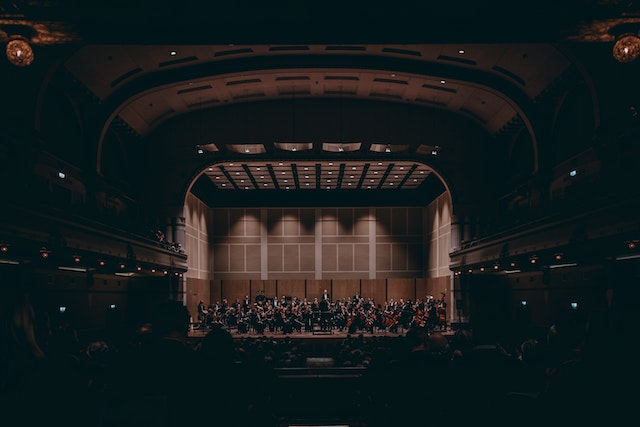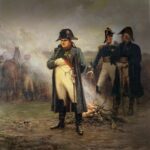Rehearsals of the Third Symphony (Eroica)
The first public rehearsal of the Third Symphony was in May or June of 1804, at the palace of Prince Lobkowicz. The room was dedicated to chamber music, but still could welcome at least two dozen of musicians and guests. The Prince offered regular concerts at this place, had his own house orchestra and often hired more, if needed. This time he had to hire, for example, a third French horn player.
Before Beethoven, rehearsals were not commonplace. Most works were sight-read in performance, even in case of Mozart or Haydn. Beethoven and his perfectionist attitude made this practice phase necessary and part of the preparations to any public concert. It seems, not only the approach, but also the musicians had to change gear to keep up with the complexity Beethoven put before them on the score.
This particular rehearsal went terribly wrong. The musicians were surprised by the level of difficulty and scope of this music. At one point Ries, Beethoven’s pupil and friend, thought that the horn player was early and made a remark. The timing turned out to be intentional. Ries remembered, “’That damned hornist!’, [I said.] ‘Can’t he count? It sounds frightfully wrong.’ I nearly got my ears boxed, and Beethoven did not forgive me for a long time.”
The composer was not in a hurry with his composition, before presenting to the public, they made several (at least four) rehearsals at Lobkowicz palaces, who owned the rights to the music for the first six months, and one event at another house.
Premiere of the Third Symphony (Eroica)
The premiere of the Third Symphony was on April 7, 1805, at the Theater an der Wien. It was part of a benefit concert for violinist Franz Clement, a friend and director of the house orchestra. Expectations were high, somehow it was in he air. Beethoven acquaintance Georg August von Griesinger wrote before the premiere,
“The Symphony has been heard at Academies at Prince Lobkowitz’s and at an active music-lover’s named Wirth, with unusual applause. That it is a work of genius, I hear from both admirers and detractors of Beethoven. Some people say that there is more in it than in Haydn and Mozart, that the Symphony-Poem has been brought to new heights! Those who are against it find that the whole lacks rounding out; they disapprove of the piling up of colossal ideas.”
Another expectation, let it be the opposite, coming from the Allgemeine Musikalische Zeitung,
“This long composition, exceedingly difficult to perform, is actually a very broadly expanded, bold, and wild fantasia. It is not at all lacking in startling and beautiful passages in which the energetic and talented spirit of its creator must be recognized; however, very often it seems to lose itself in irregularity . . . The reviewer certainly belongs to Mr. v. Beethoven’s most sincere admirers. However, in this work he must confess to finding much that is strident and bizarre, so that an overview of the whole is obscured and the unity is almost completely lost.”
At the premiere Beethoven himself was the conductor. As ever, his performance was spectacular, at loud passages rising on his toes, making wide hand gestures, at soft sections creeping under the music stand. The orchestra was well prepared by then, giving a decent execution.
The epic first movement gave a knock out to many in the audience, they were unprepared for the proportions. Someone was heard saying “I’ll give another kreuzer if the thing will only stop!”
The second movement, the Funeral March, was more familiar as this was a well-known genre. The third movement had to be an easy part to digest, but again, the last movement was nothing less than unusual. Applause was modest at the end, Beethoven did not nod in return.
Following the premiere reviews were coming. A very extensive piece appeared in Der Freymüthige,
“A new symphony in E♭ by Beethoven was performed here, over which the musical connoisseurs and amateurs were divided into several parties. One group, Beethoven’s very special friends, maintains that precisely this symphony is a masterpiece, that it is in exactly the true style for more elevated music, and that if it does not please at present, it is because the public is not sufficiently educated in art to be able to grasp all of these elevated beauties. After a few thousand years, however, they will not fail to have their effect. The other group utterly denies this work any artistic value and feels that it manifests a completely unbounded striving for distinction and oddity, which, however, has produced neither beauty nor true sublimity and power. Through strange modulations and violent transitions, by placing together the most heterogeneous things, as when for example a pastorale is played through in the grandest style, with abundant scratchings in the bass, with three horns and so forth, a true if not desirable originality can indeed be gained without much effort. However, genius does not proclaim itself by simply bringing forth the unusual and the fantastic, but rather by creating the beautiful and sublime. Beethoven himself has demonstrated the truth of this statement in his earlier works. The third, very small group stands in the middle; they admit that the symphony contains many beautiful qualities, but admit that the context often seems completely disjointed, and that the endless duration of this longest and perhaps also most difficult of all symphonies exhausts even connoisseurs, becoming unbearable to the mere amateur. They wish that Mr. v. B. would use his well-known great talent to give us works that resemble his first two Symphonies in C and D, his graceful Septet in E♭, the spirited Quintet in D Major, and others of his earlier compositions, which will place B. forever in the ranks of the foremost instrumental composers. They fear, however, that if Beethoven continues on this path, both he and music will come off badly . . . The public and Herr v. Beethoven, who conducted the work himself, were not satisfied with each other this evening. To the public the symphony was too difficult, too long, and B. himself was too impolite, since he did not nod in acknowledgment of those who did applaud.”
A second follow-up piece was published in the Allgemeine Musikalische Zeitung,
“At this concert I heard the new Beethoven symphony in E♭ . . . conducted by the composer himself, and performed by a very well-comprised orchestra. But this time as well I found no reason at all to change the judgment that I had already formed about it. To be sure, this new work of B. has great and daring ideas, and, as one can expect from the genius of this composer, great power in the way it is worked out; but the symphony would improve immeasurably (it lasts an entire hour) if B. could bring himself to shorten it, and to bring more light, clarity, and unity into the whole.”
In fact, the Eroica is shorter than one hour, but Beethoven observed in confidence, “If I wrote a symphony an hour long it will be found short enough.”
As time passed, both critics and audiences began to comprehend and love the Eroica. In 1807, after the Mannheim concert, the following review was printed,
“The first movement is impressive and full of power and sublimity . . . The funeral march is new and bears the character of noble melancholy. As long as it is, even in relation to the other movements, we are still glad to linger in the emotion it arouses . . . The scherzo menuetto is a piece full of lively, restless motion, against which the sustained tones of the three horns in the trio contrast exceptionally well . . . The finale has much value . . . however, it cannot very well escape from the charge of great bizarrerie.”
Another one from Leipzig, same year, in 1807,
“The most educated friends of art in the city were assembled in great numbers, a truly solemn attentiveness and deathlike silence reigned . . . Each movement unmistakably had the effect that it should have, and each time at the end of the entire piece loud demonstrations of applause gave vent to well-founded enthusiasm. The orchestra had voluntarily gathered for extra rehearsals without recompense, except for the honor and special enjoyment of the work itself . . . And so this most difficult of all symphonies . . . was performed not only with the greatest accuracy and precision . . . After this study, and after hearing the work repeatedly at rehearsals and public performances, we would simply like to add to this that the first, fiery, magnificent allegro, in its astounding many-sidedness within the greatest unity, in its clarity and purity within the most extensive complications, and its irresistible enchantment throughout its great length, has become and remained our favorite of all the movements.”
This symphony in its style and scope, in its unprecedented ambition, resonated with the Napoleonic era, and people were quick to embrace it. Until the Ninth, Beethoven named the Eroica as his favorite symphony.








